

Reclaim Time for Feedback with Citelighter and TechSmithTechSmith Blogs. Guest post by high school english teacher, Natalie O’Neil, written for the quarterly educator newsletter The Learning Lounge.

Attention Educators! Have you ever been up late grading after a full day of teaching and come across a student essay that was so disorganized you wanted to cut it into slips and glue it back together so you could show your students your visions of grandeur? Well guess what… I have a better solution than scissors, tape, and the snapping of your one last nerve. Bring Citelighter and TechSmith into your repertoire of teacher tools. Citelighter, a digital writing platform and TechSmith, screen capturing and recording tools, can help educators provide scaffolded, differentiated instruction effectively with visual and audio feedback that helps students truly understand how to improve their writing process.
So your students are starting to read chapter books!… We are so pleased to have the amazing Jennifer Serravallo back as a guest blogger this week sharing her expertise on reading comprehension with all of us.

Jen is the author of the Independent Reading Assessment for grades 3, 4, and 5 in Fiction and Nonfiction (Scholastic, 2012, 2013) and of the Heinemann titles Teaching Reading in Small Groups (2010) and Conferring with Readers (2007). She’s a speaker and independent literacy consultant who worked for 8 years at the TCRWP. You can find her at or follow her @jserravallo. Choice Literacy - Articles & Videos - Full Article. Was the problem that Ron and boys like him were not as literate as the as the girls in the class?
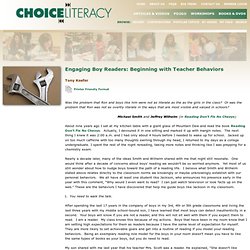
Or was the problem that Ron was not as overtly literate in the ways that are most visible and valued in schools? Michael Smith and Jeffrey Wilhelm (in Reading Don't Fix No Chevys About nine years ago I sat at my kitchen table with a giant glass of Mountain Dew and read the book Reading Don't Fix No Chevys . Actually, I devoured it in one sitting and marked it up with margin notes. Nearly a decade later, many of the ideas Smith and Wilhelm shared with me that night still resonate. You need to walk the talk. After spending the last 17 years in the company of boys in my 3rd, 4th or 5th grade classrooms and living the last three years with my middle school-bound son, I have learned that most boys can detect inauthenticity in a second. Using the 'Who Made That?' Column to Teach Reading Strategies. Jens Mortensen for The New York TimesWho made that Super Soaker?
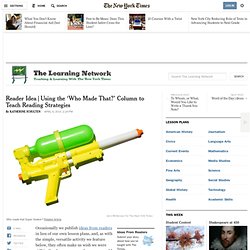
Related Article Occasionally we publish ideas from readers in lieu of our own lesson plans, and, as with the simple, versatile activity we feature below, they often make us wish we were still in the classroom ourselves so we could try them out “IRL,” as the kids say. You probably have some wonderful ideas for teaching with The Times, too. Please write in and tell us about them. Teacher: Cayne Letizia Institution: Valhalla Middle School, Valhalla, New York. Choice Literacy - Articles & Videos - Full Article. A "strategy" is a plan developed by a reader to assist in comprehending and thinking about texts, when reading the words alone does not give the reader a sense of the meaning of a text.
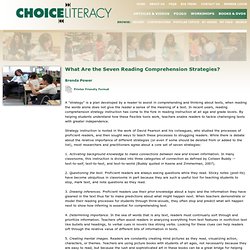
In recent years, reading comprehension strategy instruction has come to the fore in reading instruction at all age and grade levels. By helping students understand how these flexible tools work, teachers enable readers to tackle challenging texts with greater independence. Strategy instruction is rooted in the work of David Pearson and his colleagues, who studied the processes of proficient readers, and then sought ways to teach these processes to struggling readers.
While there is debate about the relative importance of different strategies (or even if some should be deleted from or added to the list), most researchers and practitioners agree about a core set of seven strategies: 1. 2. 3. 4. Reading Aloud Closely with Upper Elementary Students. A MiddleWeb Blog The wind seems to go in and out of my sails on a fairly regular basis these days.
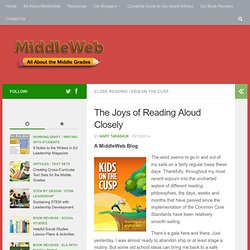
Thankfully, throughout my most recent sojourn into the uncharted waters of different reading philosophies, the days, weeks and months that have passed since the implementation of the Common Core Standards have been relatively smooth sailing. There’s a gale here and there. Just yesterday, I was almost ready to abandon ship or at least stage a mutiny. But some old school ideas can bring me back to a safe harbor when the weather is rough. Sharing a story together. Choice Literacy - Articles & Videos - Full Article. I have worked hard over the past ten years to create a culture of reading in my 11th and 12th grade English classes.
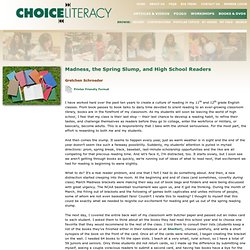
From book passes to book talks to daily time devoted to silent reading to an ever-growing classroom library, books are in the forefront of my classroom. As my students will soon be leaving the world of high school, I feel that my class is their last stop -- their last chance to develop a reading habit, to refine their tastes, and challenge themselves as readers before they go to college, enter the workforce or military, or basically, become adults. This is a responsibility that I take with the utmost seriousness.
For the most part, the effort is rewarding to both me and my students. 5 Writing Instruction Fundamentals for Success on... Get ready to say goodbye to standardized bubble tests completed with a #2 pencil.

Computer-based next-generation assessments, which measure students’ mastery of the Common Core, are upping the ante. Why Writing Skills Matter Now More Than Ever With the new PARCC and SBAC assessments on the horizon, educators are concerned about whether their students will be adequately prepared—especially when it comes to writing. 5 Reasons Spelling and Handwriting Support...
While the Common Core State Standards focus on higher-level learning, they do not state the case for every foundational skill—leaving schools with the option of choosing whether to teach essential skills such as spelling and handwriting—which are critical for reading and writing success and act as stepping stones to higher test scores.

You can keep spelling and handwriting in the curriculum and utilize research-based tools to teach these skills explicitly and efficiently without wasting valuable instructional time. Here are five evidence-based reasons for teaching spelling and handwriting explicitly and for carving out about 15 minutes a day in the reading and language arts block for each of these foundational skills: Neuroscience and brain scanning reveal that retrieving spelling patterns in a special word-form area of the left hemisphere activates reading and writing circuitry. Dr. J. Beating Dyslexia, Not Just Coping With It, A FREE Resource. When Bell-Ringers Go Bad: My Quest to Deepen Start-of-Class Activities. Published Online: January 15, 2014 By Kim McCready For most of my 14 years of teaching, I've assigned "bell work" while attending to beginning-of-class duties.
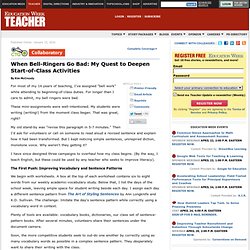
For longer than I care to admit, my bell ringers were bad. Books for Strategy Instruction. There are two types of links on this page: Book Looks and Lit Lessons. The Book Looks are brief in nature, giving a short synopsis of the book and a few possible strengths for strategy instruction. The Lit Lessons are longer, providing even more support and detailed information about teaching possibilities. Inspiring Stories from America's Great Educators.
Holly Fairbrother Year 8 (Elementary) Nexus International School Singapore 4 x 40 minute lessons Punctuation seems to cause a lot of problems for learners. I am not sure why, but many learners have failed to grasp even basic rules, such as capitalisation. Method to Our (Charting) Madness. Hi there! Greetings from the snowy, ice covered reaches of New York! We hope today’s post finds you ensconced in covers and drinking the hot beverage of your choice if you are in one of the colder areas of the world. And if you are in Hawaii, well, don’t tell us if you are in Hawaii. We chartchums have been busy writing, writing, writing and are happy to report that Smarter Charts 2 is now in the hands of the supremely dedicated and talented folks at Heinemann. We will keep you posted on its progression, and have one small teaser to unleash now… it is even better than the first book.
Now onto the short term! How to Teach Content-Related Vocabulary: Lessons from Llamas. A MiddleWeb Guest Article This article on vocabulary instruction is adapted from Lee Ann Spillane’s online interactive book, Reading Amplified: Digital Tools that Engage Students in Words, Books and Ideas (Stenhouse, 2012). See our review here. Moving From Leveled Guided-Reading Groups to Strategy-Based Groups. It can feel a little scary to move from something we know well and do proficiently to something that is new. However, if we are truly interested in meeting the individual reading needs of our students, moving to instruction that is centered on those diverse needs is a change worth making. One thing that really helped us make the shift was to abandon groups altogether for a month or so and spend all of our literacy block conferring with children one-on-one.
Redefining the Writing Process - iPad Summit Boston 2013. If%20the%20Book%20Fits,%20Read%20It! 90 Mobile Learning Modern Language Activities —a book by Harry Grover Tuttle. Choice Literacy - Articles & Videos - Full Article. “Mercy Watson is always causing trouble, but I don’t think she means to. She doesn’t always know what she’s doing.” Abby, age 6 “I love Roald Dahl books, so reading ‘Boy ’ is really fun. Eli, age 10. 8 graphic organizers for primary sources. Deb Brown, a good friend from the Shawnee Mission, Kansas district, shared a statement with me several years ago and it’s rattled around in my head ever since.
Primary sources belong to everyone. Not just the smart kids. Bell Ringer Exercises. Technologically Speaking. Text Selection Tool for Your Summer Planning! Posted by Ariel Sacks on Monday, 08/05/2013 Hello teachers of English! Blogging for Reluctant Writers: Have students share their ideas using sound and video. Indiana Jen « Education & Technology (and some History)
Online Safety With Professor Garfield. Professor Garfield is a free resource developed in part by the Virginia Department of Education. Just ASK Publications and Professional Development - Making the Common Core Come Alive! Writing. Using Games in the ELL Classroom, Part II. Giving Every Student a Voice Through Online Discussion. Published Online: September 25, 2012 First Person. Audio story. Read aloud. Descriptive Video: Using Media Technology to Enhance Writing. ReadWriteThink couldn't publish all of this great content without literacy experts to write and review for us. If you've got lessons plans, activities, or other ideas you'd like to contribute, we'd love to hear from you. Kelly Gallagher – Resources. True stories by teens written on a variety of topics. Storybird - Artful storytelling.
A Pennsylvania Teacher Shares Two Times-Related Activities. What does it mean to be literate? SmartBlogs. PreK and K: Integrating Technology for our Littlest Learners - Community Hub. Parallel Instruction for AT « Smart Kids With LD. Reading nonfiction is not optional SmartBlogs. Teacher Resources. Four Things All Educators Should Understand About the Dyslexic Brain. ZooBurst. Choice Literacy - Articles & Videos - Full Article. RTy294CommonCoreCover. Here Today, Gone Tomorrow: Preserving Culture in Changing Times. Writing Fiction Based on Real Science.